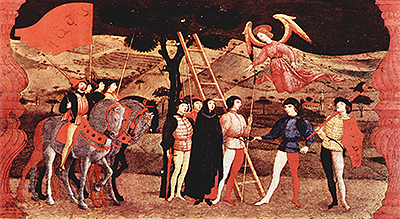The Miracle of the Desecrated Host is a series of 6-panel tempera on panel paintings developed by Paolo Uccello.
The paintings were done between 1467 and 1469. They were commissioned for the Confraternity of the Corpus Domini, who had also commissioned the Joos van Wassenhove’s painting known as The Communion of the Apostles (also known as The Institution of the Eucharist). The Miracle of the Desecrated Host was completed on October 1469 when Paolo received his final payment.
Scene Four from The Miracle of the Desecrated Host rests on a 43 x 58 cm panel. In this scene, the story of the Miracle of the Desecrated Host is told where the woman is punished while an angel descends from heaven. The story on scene 4 is a continuation of an anti-semitic story that was inspired by Bernardino of Siena’s sermons. Just after the host has attended a procession of consecration, Scene Four from The Miracle of the Desecrated Host showcases that the host has not been absolved. The kind of punishment given to the woman of being burnt at the stake was common at the time. Because even after the woman is burnt, others are also burnt in the next scenes.
Paolo Uccello’s style of painting expresses his narrative ability to use lively colours and fairytale kind of mood in his painting. You can see how he uses black shades on the background and the lively colours on the people. The predella painting currently resides at the Galleria Nazionale delle Marche, Urbino. It was originally at Santa Agatha, then it was later moved to the Scolopi College. In 1858, it got last and then it was rediscovered in a barn. It might have been used for another purpose because it was damaged before it was sent to the Ducal Palace. The original colours were covered with lime traces because of how the painting was misused. But in 1954, it was restored, and the previous repairs and paintings were done, This restoration brought the originality of the painting back to life.




